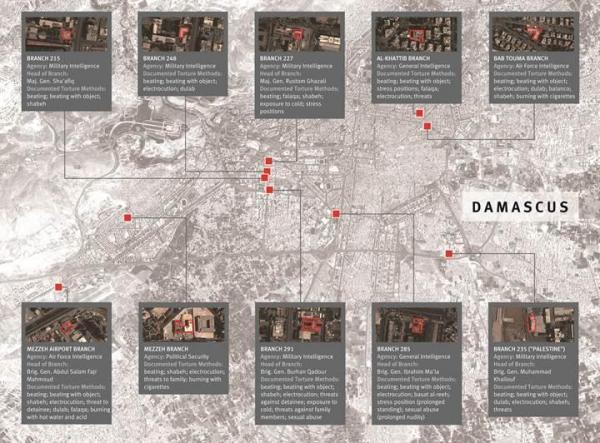Military Security, Aleppo
The Military Security Branch or the Military Investigation Branch of Aleppo is situated in a huge building that consists of several other buildings that together resemble a castle at the intersection of Al-Shahaba and New Aleppo neighbourhoods with Al-Furqan neighbourhood, with the three being among Aleppo’s most important and most prestigious neighbourhoods. An an earlier stage, the building had included a vast square in addition to a number of buildings at the Syrian (Syriac) neighbourhood, which was a popular old neighbourhood with a Christian and Assyrian majority, and one of the most important security fortresses of the regime of Hafez al-Assad and his son Bashar al-Assad. This branch is known for its rough and rugged staff due to the close relationship between the Higher Commander of Military Intelligence and the special chambers of the Presidential Palace in Aleppo, and because it represents the regime’s iron fist that is used to oppress and suppress the whole Syrian people. This branch is also known for the high death rate among its detainees. Any citizen who is summoned to this branch is unlikely to leave it alive; it is a rarity if they do.
The branch was relocated to a new building that dates back to 2009. It was now equipped by a variety of weapons and ammunition that make it capable of countering any imagined attack. This explains why it has survived the war so far.
Around the beginning of the Syrian crisis, the regime fabricated a tremendous explosion at the branch and immediately scattered around it the corpses of more than 300 former detainees who had apparently been tortured to death in the basement dungeons. The regime claimed that the opposition were behind the blast, although the building remained intact, except for minor scratches on the external walls.
The branch’s approach to investigation includes torturing a detainee for four successive hours, without even asking them for their name. This is meant to destroy the detainee’s ability to resist or reserve any information that might affect them or their family. At this point a detainee is forced to write [and sign] a statement with all the charges against them.
Those who have entered the branch – I met dozens of survivors from this prison whether in the 1980s or post 2011 – know that only 65% of detainees make it out alive as a result of the excessive torture to extract information or to force detainees to admit any charges against them.
Those who have entered the branch – and I met dozens of survivors from this prison both in the 1980s and after 2011 – know that only 65% of the detainees make it out alive as a result of the excessive torture which aims to extract information from the detainees or to force them to admit all the accusations against them.
